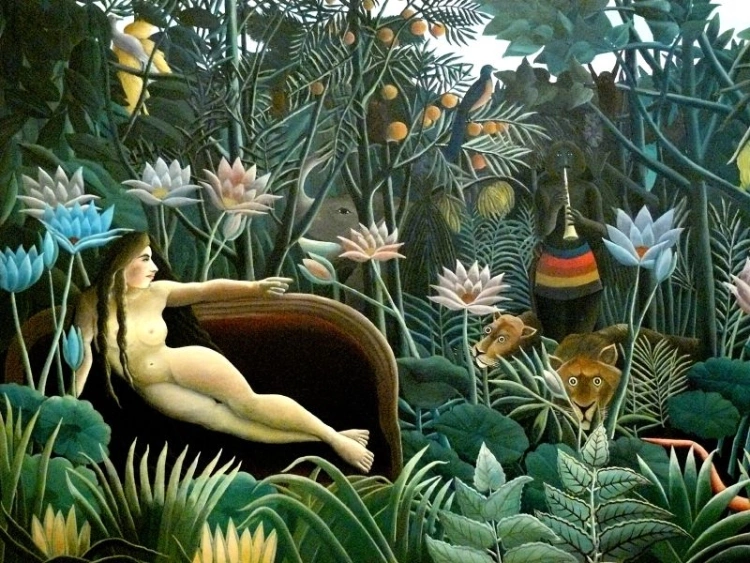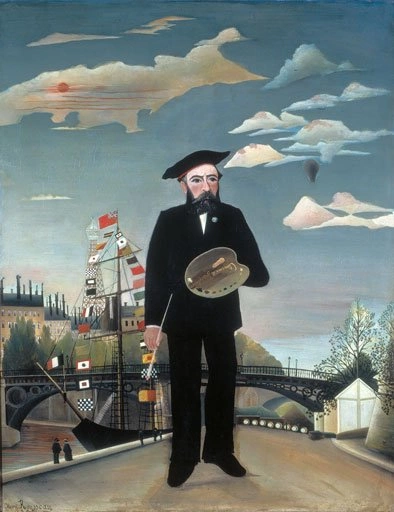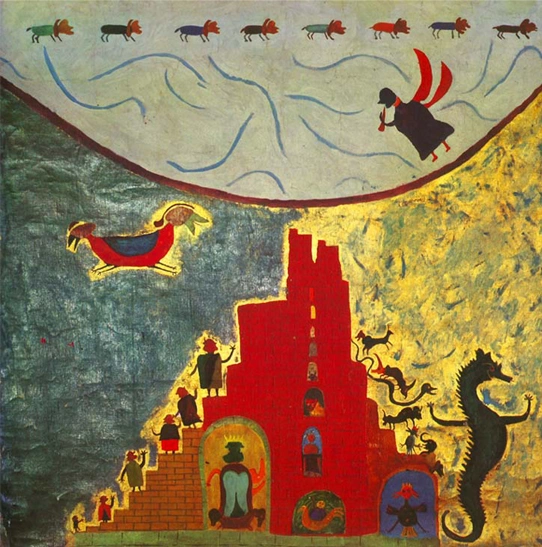The Term Dada Refers to Art That Has a Very Naive Childlike Approach
At that place is a colourful world filled with fabulous details, where everything seems peacefully flying and takes a person dorsum to his childhood, evoking coziest memories. That'due south the earth of naive art.

Term naiverefers to something that lacks experience, judgment or wisdom, something natural and unaffected, innocent.
In art, information technology doesn't change the meaning. Naive art includes nigh all of these. Naive artists have no relevant educational activity, they paint without whatsoever sensation of beefcake, technique or perspective, and their paintings are simple, bright, artless – innocent.
Naive art is any form of visual art created past individuals who lack or reject conventional teaching and guidance that professional artists receive. It disagrees with dominant trends in art of their time.
These artists shouldn't exist dislocated with "Sunday artists", who paint for fun. Too, information technology'south wrong to have naive artists for those who don't know what they're doing. They create with the same passion equally educated and well-trained artists, just without formal knowledge of methods.
Beginnings and Henri Rousseau
It is hard to decide when and where this genre exactly originate. End of the 19th and showtime of the 20th century is the fourth dimension when this genre started getting more attention and appreciation.
The 20th century was a century of experimentation when traditional means of expression were left bated and artists were experimenting with new means of seeing the globe and were representing it in an original way.

In that time naive art was discovered. The main figure in naive art was French painter Henri Rousseau, who was discovered past Pablo Picasso.
Henri Rousseau (1844-1910), retired price and taxation collector (that's why he got a nickname Le Douanier – the customs officeholder), started painting as a middle-anile human being and was self-taught.
He had been exhibiting since 1886, but nobody gave value to his piece of work.
The first person who actually paid attention to his piece of work was immature Pablo Picasso. He was amazed by Rousseau and considered him a true luminescence.
Rousseau's works are the most oft reproduced examples of naive art. He was painting portraits, exotic vegetation and jungle scenes, although he had never left France or visited a jungle.
He found his inspiration in children'south books and the botanical gardens of Paris. The magical globe of his paintings doesn't demand any explanation (nor is it possible) in order to be understandable, to speak to the audition.
Peradventure precisely considering of that, its magic becomes and so real.
In his works was finally gained a frank virtue of emotion that Gauguin was trying then hard to achieve. Picasso and his friends considered him every bit the father of 20th-century painting.
Rousseau influenced many avant-garde painters, including Picasso, Jean Hugo, Surrealists and others. They adopted the creative person's sense of freedom and instinctive approach to the composition.

Characteristics of Naive Art
Colorful, childlike simplicity and frankness are words that best depict paintings of naive art.
This genre turns the reality of adulthood into weightless joys of youth. Information technology creates an contradistinct, lighter reality. This is reached in different ways.
Ofttimes, there is an inconvenient relationship with the formal standard of painting. For example, artists ignore three rules of perspective which say that the size of objects must decrease proportionally with distance, the color must be muted with distance and precision of details decrease with distance.
Breaking the rules is essentially what naive artist does, probably unconsciously, producing works that are geometrically inaccurate with kleptomaniacal perspective and uneven shapes, as a outcome.
Also, details appear equally rich, no matter if they are in foreground or groundwork. This makes an illusion that figures are floating or positioned in infinite without anything solid anchoring them in identify.
The absenteeism of perspective is one of the nigh of import characteristics of naive fine art. Paintings convey a sense of frozen motion and deep, calm space, which contributes the feel that objects are floating.
Naive painters use beautiful, vivid, saturated colors that aren't matching reality, rather than subtle mixtures, tones and shades.
Figures in paintings are commonly shown full face or absolutely strict profile. They rarely cover upward much of a face and virtually never paint figures entirely from the dorsum.
Intensity and passion are communicated through the figures, especially their staring eyes and preciseness of line and color.
Details are remarkably well-divers, which, besides bright colors, adds to the liveliness of a painting.

Well-nigh common motifs are alive creatures, people and flora, nature, folklore motifs, and lives of ordinary people, specially rustic scenes.
The focus is on lively characters and rarely on lifeless objects. They paint exotic places, fifty-fifty if they've never been there (for instance Rousseau'south jungle), fantastic creatures, wild animals, everyday-life scenes, rural life scenes (farmers, mowing the fields, shepherds, pets etc.), landscapes, landscapes under snow, sledding and much more.
Naive Artists
Rousseau is undoubtedly the most influential naive artist, but there are other artists of this genre who are worth mentioning.
Antonio Ligabue, an Italian painter, was one of the virtually important naive artists of the 20th century. He gained recognition for his work during the 1940s.
Russian painter Nikifor created over 40 000 paintings. Sidney Nolan created landscapes that aimed to celebrate Australian history. Grandma Moses started her artistic career at the historic period of 78 and was known for her take on American realism.
Serbian painters from Kovačica (well-nigh famous is Zuzana Halupova) create great panoramic paintings.
Ilija Bašičević Bosilj, outsider and naive painter, uneducated Serbian farmer, started painting equally a middle-aged man, and despite that had solo exhibitions fifty-fifty in New York.
 Connectedness to other art genres
Connectedness to other art genres
Naive fine art is often connected to primitivism, primitive (tribal) fine art, and confused with folk and outsider art.
Primitive art refers to tribal art from Africa, the Due south Pacific and Republic of indonesia, prehistoric and very early European art. Primitivism is used to draw any art that imitates or is characterized by archaic fine art.
Folk art is utilitarian and decorative art that expresses national identity. Commonly, folk artists are uneducated, as well equally naive artists. It's obvious why folk and naive fine art easily confused.
Outsider art represents any work of fine art that is created by socially and culturally marginal people – undereducated, mentally ill, prisoners – unconnected to the conventional fine art world.

Appreciation of naive art has increased over years. Today, information technology is completely recognized art genre that is spread and represented in galleries all over the world.
shapirosanclaus1973.blogspot.com
Source: https://davidcharlesfox.com/naive-art-brighter-reality/
0 Response to "The Term Dada Refers to Art That Has a Very Naive Childlike Approach"
Publicar un comentario